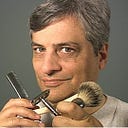There is a lot of information about shaving brushes on the internet but a lot of it is scattered about and some of it is not summarized very well. So I decided to distill the essentials down into a “frequently asked questions” list.
What does a shave brush do? What is it made for?
A shave brush is a way to prepare stubble for shaving by mixing lathering cream or soap with water to make an effective lubricant for a razor blade to track on.
What are the benefits of a shave brush?
Hydration: a shave brush mixes lathering cream or soap with water to make an effective lubricant. It also reduces the amount of air in the lather, preventing the skin from prematurely drying and possibly causing irritation.
Cleaning And Exfoliation: using a shave brush produces a mild exfoliating effect on the skin.
Lather Coverage: when shave products are applied with just fingers, hairs tend to matte to the face, making them more difficult for the razor’s blade edge to get at. A shave brush lifts hair and surrounds it with lather, requiring less work from the razor.
A Better Shave Experience: for some, that feeling of applying a warm, fragrant lather on the face is very relaxing and appealing.
What are shaving brushes made of?
Shaving brush hair knots are typically made out of badger hair, boar hair, horse hair, or synthetic material.
What are the different grades of badger hair?
Unfortunately there is no standardized grading process. But here are some general guidelines:
The lowest grade of badger hair is generally referred to as “pure.” This grade is characterized by a dark color and thick, relatively stiff, coarse-looking hair. Some manufacturers will bleach the hair slightly to make it appear like a higher grade but the hair itself will still look coarse.
The next grade is usually called “super,” best,” or “fine.” These mid-tier brushes are generally better constructed and the hair is finer-looking, softer, and lighter in color. These brushes retain water and heat noticeably better-sometimes dramatically better-than lower grades.
The highest grade of badger hair is usually labeled “silvertip” (though a couple manufacturers refer to these as “Super”). These brushes are typically made to the highest standard, often with hand-crafted workmanship, commanding the highest prices. Silvertip hair is often cream colored on top with darker bands of color below and very fine but still fairly flexible hairs. These brushes will retain even more water and heat than super badger brushes, but is a less dramatic improvement.
Are badgers killed for shaving brushes?
Yes, badgers (and boars) are killed for their pelts. Horse hair is taken from grooming cast-offs: the horse is not harmed.
What do the dimensions of a shaving brush mean?
There are two important specifications with shave brushes: loft (the height of the hair from knot to tip) and knot (the diameter of hair at the base).
How long do shaving brushes last?
Some say a shave brush should last a lifetime but it really depends on how well built the brush is and how well the shaver takes care of it. The typical lifetime of an average shave brush is 5–10 years.
Which shaving brush is best?
It depends on what you are looking for in a brush. Here are Sharpologist’s recommendations for the best shaving brush in different categories.
How do I choose a shaving brush?
Narrow down your choices by deciding what kind of hair you want, the size of the brush, the shape of the brush top (“bulb” or “fan”) and price.
Is a shaving brush stand necessary?
As long as the brush is properly used and maintained a stand is not necessary unless it is specifically recommended by a manufacturer.
How do you use a shaving brush?
There are some variations on how to make a good lather with different products, and it can take a little practice to get right. There are two general schools of thought on making traditional shaving lather, differentiated mostly on how water is integrated into the mix. The classic method of lather-making starts with minimal water on the brush, adding water until you get the lather consistency you are looking for. Another school of thought starts out with more water on the shaving brush which the excess is drained in a particular manner. Neither method is right nor wrong. Try both methods to see what works best for you.
Originally published at https://sharpologist.com on January 15, 2020.
